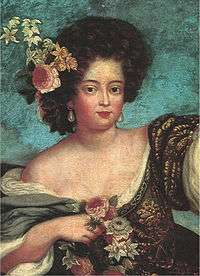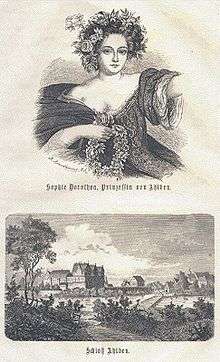Sophia Dorothea of Celle
| Sophia Dorothea of Celle | |
|---|---|
| Electoral Princess of Hanover | |
 Sophia Dorothea with her children | |
| Born |
15 September 1666 Celle, Germany |
| Died |
13 November 1726 (aged 60) Ahlden, Germany |
| Spouse | |
| Issue | |
| House | Hanover |
| Father | George William, Duke of Brunswick-Lüneburg |
| Mother | Eleonore Desmier d'Olbreuse |
Sophia Dorothea of Celle (15 September 1666 – 13 November 1726) was the repudiated wife of future King George I of Great Britain, and mother of George II. The union with her first cousin was an arranged marriage of state, instigated by the machinations of his mother, Sophia of Hanover. She is best remembered for her alleged affair with Philip Christoph von Königsmarck that led to her being imprisoned in the Castle of Ahlden for the last thirty years of her life.
Early life and marriage
Sophia Dorothea was born on 15 September 1666, the only child of George William, Duke of Brunswick-Lüneburg by his long-term mistress, Eleonore d'Esmier d'Olbreuse (1639–1722), Countess of Williamsburg, a Huguenot lady, the daughter of Alexander II d'Esmiers, Marquess of Olbreuse. George William eventually married Eleonore officially in 1676 (they had been married morganatically previously).
There was some talk of marriage between Sophia Dorothea and the (then) future king of Denmark, but the reigning queen was talked out of it by Sophia of Hanover (her future mother-in-law). Another engagement, to the Duke of Brunswick-Wolfenbüttel, was broken off after Duchess Sophia convinced her brother-in-law of the advantage of having Sophia Dorothea marry her cousin. This occurred on the day the engagement between Sophia Dorothea and the Duke was to be announced.
When told of the change in plans and her new future husband, Sophia Dorothea shouted that "I will not marry the pig snout!" (a name by which he was known in Hanover), and threw against the wall a miniature of George Louis brought for her by Duchess Sophia. Forced by her father, she fainted into her mother's arms on her first meeting with her future mother-in-law. She fainted again when presented to George Louis.
On 22 November 1682, in Celle, Sophia Dorothea married her cousin, George Louis. In 1705 he would inherit the Principality of Lüneburg after the death of his father-in-law and uncle, George William, Duke of Brunswick-Lüneburg, and in 1714 the Kingdom of Great Britain and the Kingdom of Ireland and became King George I of Great Britain through his mother, Duchess Sophia, a granddaughter of James VI and I.
The marriage of George Louis and Sophia Dorothea was an unhappy one. His immediate family, especially his mother Duchess Sophia, hated and despised Sophia Dorothea.
The desire for the marriage was almost purely financial, as Duchess Sophia wrote to her niece Elizabeth Charlotte, "One hundred thousand thalers a year is a goodly sum to pocket, without speaking of a pretty wife, who will find a match in my son George Louis, the most pigheaded, stubborn boy who ever lived, who has round his brains such a thick crust that I defy any man or woman ever to discover what is in them. He does not care much for the match itself, but one hundred thousand thalers a year have tempted him as they would have tempted anybody else".[1]
These feelings of contempt were shared by George Louis himself, who was oddly formal to his wife. Sophia Dorothea was frequently scolded for her lack of etiquette, and the two had loud and bitter arguments. Things seemed better after the birth of their first two children:
- George Augustus, born 1683, later King George II of Great Britain
- Sophia Dorothea, born 1686, later wife of King Frederick William I of Prussia, and mother of Frederick the Great
But George Louis acquired a mistress, Melusine von der Schulenburg, and started pointedly neglecting his wife. His parents asked him to be more circumspect with his mistress, fearful that a disruption in the marriage would disrupt the payment of the 100,000 thalers.
Affair with Königsmarck


George Louis and Sophia Dorothea became estranged—George preferred the company of his mistress, Melusine von der Schulenburg, and Sophia Dorothea, meanwhile, had her own romance with the Swedish Count Philip Christoph von Königsmarck. Threatened with the scandal of an elopement, the Hanoverian court, including George's brothers and mother, urged the lovers to desist, but to no avail. According to diplomatic sources from Hanover's enemies, in July 1694 the Swedish count was killed, possibly with the connivance of George, and his body thrown into the river Leine weighted with stones. The murder was claimed to have been committed by four of Ernest Augustus's courtiers, one of whom (Don Nicolò Montalbano) was paid the enormous sum of 150,000 thalers, which was about one hundred times the annual salary of the highest paid minister.[2] Later rumours supposed that Königsmarck was hacked to pieces and buried beneath the Hanover palace floorboards.[3] However, sources in Hanover itself, including Sophia, denied any knowledge of Königsmarck's whereabouts.[2]
George's marriage to Sophia Dorothea was dissolved, not on the grounds that either of them had committed adultery, but on the grounds that Sophia Dorothea had abandoned her husband. With the agreement of her father, George had Sophia Dorothea imprisoned in Ahlden House in her native Celle, where she stayed until she died more than thirty years later. She was denied access to her children and father, forbidden to remarry and only allowed to walk unaccompanied within the mansion courtyard. She was, however, endowed with an income, establishment, and servants, and was allowed to ride in a carriage outside her castle, albeit under supervision.[4] She remained under house arrest until her death more than thirty years later. Sophia Dorothea is sometimes referred to as the "princess of Ahlden".

Death and burial
Sophia Dorothea fell ill in August 1726. She died aged 60 on 13 November 1726 of liver failure and gall bladder occlusion.
George placed an announcement in The London Gazette to the effect that the "Duchess of Ahlden" had died,[5] but would not allow the wearing of mourning in London or Hanover. He was furious when he heard that his daughter's court in Berlin wore black. Sophia Dorothea's body was put into a casket and deposited in the castle's cellar. It was quietly moved to Celle in May 1727 to be buried beside her parents in the Stadtkirche.[6] George I died four weeks later while visiting Hanover.
Popular culture
Sophia Dorothea's affair and its tragic outcome is the basis of the 1948 British film Saraband for Dead Lovers. She is played by Joan Greenwood.
Ancestry
| Ancestors of Sophia Dorothea of Celle | |||||||||||||||||||||||||||||||||||||||||||||||||||||||||||||||||||||||||||||||||||||||||||||||||||||||||||||||||||||||||||||||||||||||||||||||||||||||||||||||||||||||||||||||||||||||||||||||||||||||||||||||||||||||||||||||||||||||||||||||||||||||||||||||||||||||||||||||||||||||||
|---|---|---|---|---|---|---|---|---|---|---|---|---|---|---|---|---|---|---|---|---|---|---|---|---|---|---|---|---|---|---|---|---|---|---|---|---|---|---|---|---|---|---|---|---|---|---|---|---|---|---|---|---|---|---|---|---|---|---|---|---|---|---|---|---|---|---|---|---|---|---|---|---|---|---|---|---|---|---|---|---|---|---|---|---|---|---|---|---|---|---|---|---|---|---|---|---|---|---|---|---|---|---|---|---|---|---|---|---|---|---|---|---|---|---|---|---|---|---|---|---|---|---|---|---|---|---|---|---|---|---|---|---|---|---|---|---|---|---|---|---|---|---|---|---|---|---|---|---|---|---|---|---|---|---|---|---|---|---|---|---|---|---|---|---|---|---|---|---|---|---|---|---|---|---|---|---|---|---|---|---|---|---|---|---|---|---|---|---|---|---|---|---|---|---|---|---|---|---|---|---|---|---|---|---|---|---|---|---|---|---|---|---|---|---|---|---|---|---|---|---|---|---|---|---|---|---|---|---|---|---|---|---|---|---|---|---|---|---|---|---|---|---|---|---|---|---|---|---|---|---|---|---|---|---|---|---|---|---|---|---|---|---|---|---|---|---|---|---|---|---|---|---|---|---|---|---|---|---|---|---|---|
| |||||||||||||||||||||||||||||||||||||||||||||||||||||||||||||||||||||||||||||||||||||||||||||||||||||||||||||||||||||||||||||||||||||||||||||||||||||||||||||||||||||||||||||||||||||||||||||||||||||||||||||||||||||||||||||||||||||||||||||||||||||||||||||||||||||||||||||||||||||||||
Footnotes
- ↑ Herman 2006, p. 100.
- 1 2 Hatton, Ragnhild (1978). George I: Elector and King. London: Thames and Hudson. pp. 51–61. ISBN 0-500-25060-X.
- ↑ Farquhar, Michael (2001). A Treasury of Royal Scandals. New York: Penguin Books. p. 152. ISBN 978-0-7394-2025-6.
- ↑ Hatton, pp. 60–64
- ↑ Michael L. Nash (9 February 2017). Royal Wills in Britain from 1509 to 2008. Palgrave Macmillan UK. ISBN 978-1-137-60145-2.
- ↑ Leslie Carroll (5 January 2010). Notorious Royal Marriages: A Juicy Journey Through Nine Centuries of Dynasty, Destiny,and Desire. Penguin Publishing Group. ISBN 978-1-101-15977-4.
- 1 2 Weir 2002, pp. 272–275.
- 1 2 Haag, Haag & Bordier 1877, pp. 347–349.
References
- Herman, Eleanor (2006). Sex with the Queen. New York: Harper Collins. ISBN 0-06-084673-9.
- Haag, Eugène; Haag, Émile; Bordier, Henri Léonard (1877). La France Protestante (in French). Paris: Sandoz et Fischbacher.
- Weir, A. (2002). Britain's Royal Families - The Complete Genealogy.
Attribution

- W. F. Palmblad, ed., Briefwechsel des Grafen Königsmark and der Prinzessin Sophie Dorothea von Celle (Leipzig, 1847)
- A. F. H. Schaumann, Sophie Dorothea Prinzessin von Ahlden
- A. F. H. Schaumann, Kurfürstin Sophie von Hannover (Hanover, 1878)
- C. L. von Pöllnitz, Histoire secrette de la duchesse d'Hanovre (London, 1732)
- W. H. Wilkins, The Love of an Uncrowned Queen (London, 1900)
- A. Köcher, "Die Prinzessin von Ahlden," in the Historische Zeitschrift (Munich, 1882)
- Vicomte H. de Beaucaire, Une Mésalliance dans la maison de Brunswick (Paris, 1884)
- Alice Drayton Greenwood, Lives of the Hanoverian Queens of England, vol. i (1909)